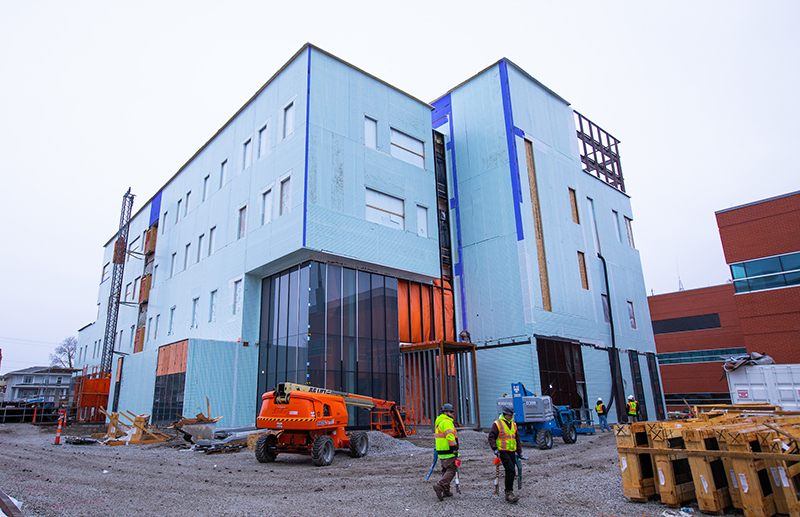Editor's note: This feature is the launch of news service's 2024 Innovation at Work series of stories, photos and videos that highlight economic development and the impact of Iowa State's contributions across the state. A new entry will post every Tuesday through April 23.
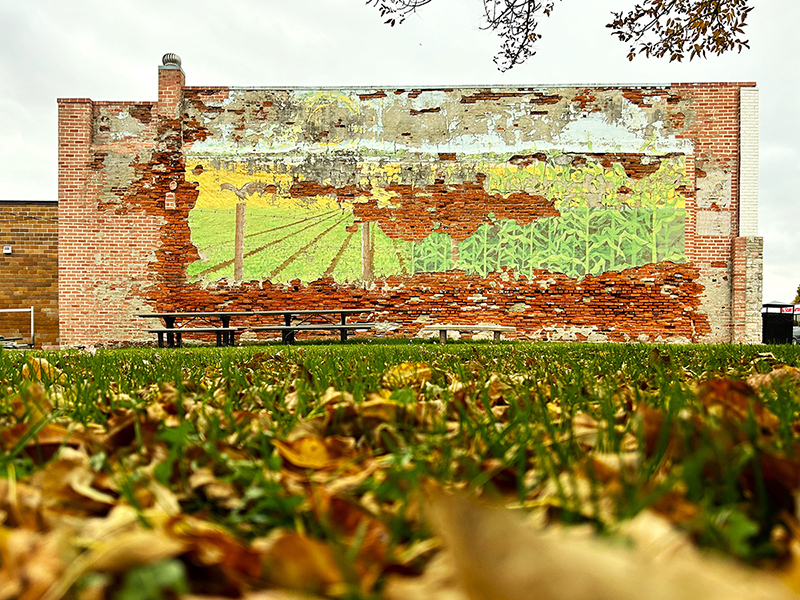
Original downtown mural in Emmetsburg's "Mural Park" pocket park. Photo by Gretchen Reichter.
It's a dry, fall day in northwest Iowa. Gretchen Reichter walks through Emmetsburg's downtown, passing storefronts adorned with scarecrows from a recent retail competition. The community's marketing and development coordinator stops when she reaches a gap between two businesses. Faded murals of sunflowers and a cornfield cling to the brick walls on either side of the pocket park.
Helping Iowa communities
Under the umbrella of Iowa State University Extension and Outreach, Community and Economic Development specialists work with local governments, regional and state agencies, community organizations and others to deliver tailored programs and services related to:
- Civic engagement and equity
- Local government and housing
- Data and technology
- Food systems
- Community and business development
"We want it to be an immersive park and something people really want to spend time in," said Reichter, explaining the plan to add a patio, benches, string lighting and garden beds. "Down the road, we'd like to put in outdoor musical instruments for kids and a pergola for live music and for county conservation to provide outdoor educational sessions."
Across town, Reichter points out several transportation improvements. Flashing beacons urge drivers to slow down near the elementary school. Painted lines on roads separate cars and bikes, and a new trail connects the middle and high schools with the hospital and Iowa Lakes Community College.
These and other project priorities in Emmetsburg emerged from participating in the Iowa's Living Roadways Community Visioning Program in 2020-21. The program is a collaboration between Iowa State University Extension and Outreach Community and Economic Development (CED), the Iowa Department of Transportation, the nonprofit organization Trees Forever, private-sector landscape architects and community stakeholders. Since its creation in 1996, 258 towns have participated, 40 of which have been in the program more than once.
Over a year-long process, experts in landscape planning and design bring community members together to identify challenges and opportunities. For some, this turns into downtown streetscaping with native plants and benches, new trails and better access to waterways. For others, the focus has been on safer pedestrian crossings and routes to schools, welcoming town entrances and stormwater management.
A recent survey led by ISU Community Visioning Program staff found 98% of communities completed at least one project after participating in the program, and nearly half finished four or more.
While the visioning program doesn't fund the projects, each town receives research and design services equivalent to $100,000 -- for free. It also helps connect participants to state and federal grants that can turn design concepts into reality.
As a member of the volunteer steering committee in Emmetsburg, Reichter was instrumental in organizing meetings to collect community input, and she continues to play a big role moving projects forward.
"I really like the Community Visioning Program because it provides dedicated time to focus on issues and priorities that you may not have time to focus on otherwise," Reichter said.
In the future, this could include the transformation of a three-block section between Main Street and Five Island Lake. It's the main corridor to reach the waterfront and where Emmetsburg hosts its Fourth of July events, which draw in residents and tourists from throughout the region.
The design boards show medians with bioswales and native plants, pedestrian lighting, benches and decorative pavers. Reichter said these changes would enhance a space that's part of Emmetsburg's history and culture.
"Some of these projects will hopefully get more bodies downtown to support local businesses, but more broadly, they can help attract and retain our key workforce, like teachers, doctors, to sustain our community. That has a huge impact on the economy moving forward," Reichter said.
Community Visioning Program: "Planning 101"
Julia Badenhope, professor of landscape architecture and Community Visioning's principal investigator, said the program is "like Planning 101 and a springboard to do more." Most of the towns that participate each year have populations under 2,000.
Video
See how Iowa's Living Roadways Community Visioning group works to help Iowa communities improve and thrive.
"One of the things I find amazing about rural Iowa is the civic culture, sense of community trust and this deep connection to the lifestyle and environment. This program works to empower people and build on those cultural dimensions," Badenhope said.
While the program has evolved and expanded over the last 27 years, it's rooted in research Badenhope conducted as a landscape architect for ISU Extension and Outreach.
"During the first three years in that role, I did a deep dive into understanding community action and gaps in design services in rural Iowa. Based on that, I saw an opportunity for extension to step in and bring communities of practice together," Badenhope said.
She developed and piloted the Community Visioning Program with the Iowa DOT. Mark Masteller, the state agency's now-retired chief landscape architect, was there from the start.
"Originally, the DOT was interested in this because we have always permitted people to do plantings on the highway right-of-way, but they often don't have any professional expertise. I remember getting a plan drawn on a napkin," Masteller said. "The Community Visioning Program was a big help to the DOT to have these smaller communities access professional services and get more buildable plans."
Badenhope emphasizes that the program is an "opportunity to weave a web of service" between the public and private sectors across Iowa.
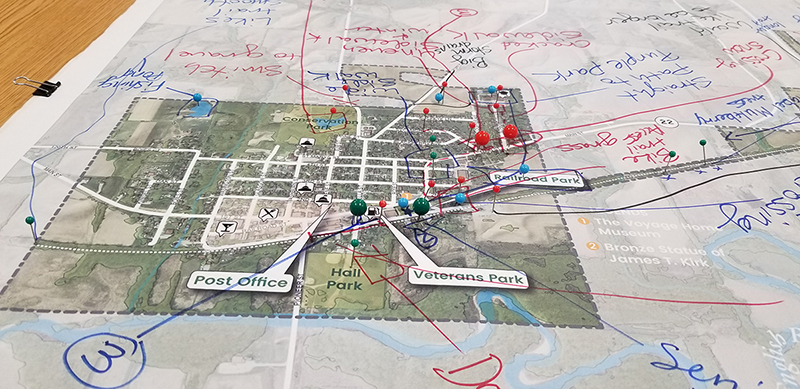
Notes and pins mark a map of Riverside in southeast Iowa from a focus group in 2022. Photo by Sandra Oberbroeckling, Iowa State University.
What’s included in the "web of service?"
Every November, 10 community applicants are accepted into the program. Trees Forever organizes monthly meetings and assessments with each town's volunteer steering committee. Meanwhile, Chad Hunter, a lecturer and project manager with the landscape architecture department, leads a group of student interns to create large maps for each community. They collect data about the local topography, vegetation, watersheds and transportation networks.
In the spring, facilitators from CED, Trees Forever and partnering landscape architecture firms conduct focus groups, using the maps to understand how residents walk, roll and drive across town. They discuss transportation-related barriers and assets and share ideas for improvement.
Sandra Oberbroeckling, Community Visioning Program project manager and CED communications specialist, said it's important to get a wide cross section of the community. Focus groups include people with mobility challenges, parents, youth, older adults and outdoor recreation enthusiasts. In towns with larger populations, the program also conducts a random-sample survey.
"We really want people who live in the communities to take ownership of the projects. If they have more input early on, that's more likely. They may be more willing to volunteer and see the project through to the end," Oberbroeckling said.
After the focus groups meet, Community Visioning Program staff and students distill community input into a series of presentation boards while a private-sector landscape architecture firm assembles an infrastructure assessment. Both go to the steering committee, which prioritizes projects. Residents provide feedback through several public events, and then the landscape architecture firm creates conceptual designs. The firms are required to hire student interns who are involved throughout the process.
By the fall, each community has several fleshed-out project designs with feasibility reports and cost estimates. A Trees Forever field coordinator continues to follow up with the steering committee, providing guidance on implementing projects and applying for grants.
Badenhope explains some towns join the Main Street Iowa Program, which is part of a national initiative aimed at revitalizing historic downtowns. Others work with the Iowa Department of Agriculture and Land Stewardship on urban watershed projects or CED on a community housing assessment.
"Some of these projects are going to be really quick and easy, maybe tree planting or a mural. Other projects are going to take years to implement because the community will wait to implement an enhancement when it's tearing up the street for sewer or gutter improvements," said Jeff Jensen, director of community programs for Trees Forever. "So, it's good to have short-term goals and also some longer-term goals."
Outdoor recreation and disaster recovery
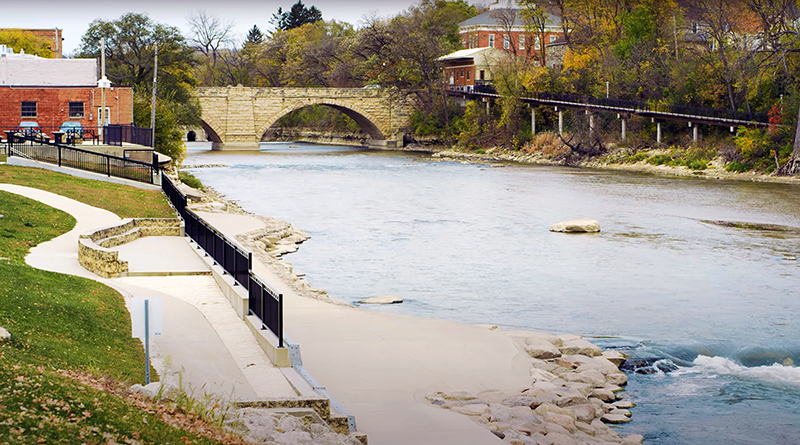
Elkader's ADA-accessible riverwalk and whitewater feature draw locals and tourists to the Turkey River. Photo by Sandra Oberbroeckling, Iowa State University.
Projects that emerge from the Community Visioning Program reflect the needs and priorities of rural Iowa, some of which have shifted over the years.
"When I first started, it was more about entryway enhancements and roadside plantings, which is all still relevant, but it has expanded more to focus on trails and accessibility and healthy lifestyles," Oberbroeckling said.
Looking to the future, the project manager expects more communities will also focus on mitigating and recovering from natural disasters.
"Transportation is not just the roads and sidewalks. It's trees and bioswales, permeable pavement, all of which can help a community be more resilient," she said.
Oberbroeckling points to Mapleton in western Iowa as an example. In 2011, an EF5 tornado destroyed 60% of the town's tree canopy. Through the Community Visioning Program, residents found out the denuded areas had more flooding, spurring projects to improve Mapleton's stormwater management.
The program has aided other communities devastated by tornados, including Parkersburg, and the 2020 derecho.
Elkader, a historic town tucked into a limestone-bluff valley in northeast Iowa, first applied for Community Visioning following record flooding in 2008. The Turkey River that flows through its downtown and stone-arch bridge draws anglers and paddlers from across the region. But after weeks of heavy rain, a surge of water, mud and debris inundated 53 homes and 28 businesses and broke municipal pipes carrying fresh water and sewage.
As the community cleaned up the destruction, the city bought out 30 homes in the floodplain and decided to turn the 11-acre parcel into a park. Community Visioning helped Elkader conceptualize the trails, soccer fields, playgrounds, picnic and performance pavilions, a labyrinth and a butterfly garden. Elkader City Administrator Jennifer Cowsert says Founders' Park provided space for the town to revitalize its annual summer festival and create a new one, the Art in the Park Festival.
A new riverwalk and a whitewater feature for kayakers also resulted from the Community Visioning Program.
"Before the project, the river access was just some concrete stairs. Now, lots of people use the river access for family photos and prom, and of course, recreation. An older resident in a motorized wheelchair goes there to fish regularly, and with the whitewater feature, we've attracted a whole new crowd," Cowsert said.
Similar to nearby towns Manchester and Charles City, Elkader replaced its low-head dam and installed rock features to create waves, eddies and drops. The three towns have a marketing collaboration to attract kayakers from across Iowa and the Midwest.
Elkader participated in the program again during the 2019-20 cycle. The community prioritized connecting more trails and building a pedestrian bridge over the Turkey River for future projects.
"Right now, we have just two buildings downtown that are vacant. For a town our size, that's pretty good. So, I think all of these projects factor into having a strong downtown and quality of life," Cowsert said.
Building momentum for bigger projects
Near the Loess Hills in western Iowa, combines and trucks trace golden fields and fence lines. In the distance, across the Boyer River and the largest remnant of the historic Lincoln Highway, a 65-foot-tall metal corn stalk with LEDs adorns an old grain elevator.
"We like to say the grain elevator 'lights our way home,'" said Deb Sprecker, executive director of Woodbine Main Street. Before the public art installation, the 1940s milk-carton-shaped structure was in danger of being demolished.
"It was considered an eyesore, right at the town's gateway. However, many residents remembered tagging along with grandpa in hopes of a cold soda from the cooler or listening in on lively discussions and local gossip," Sprecker said. "The community rallied to save it, and now it's an iconic piece of Woodbine culture and a quirky 'mile marker' for travelers going from Omaha to Ames."
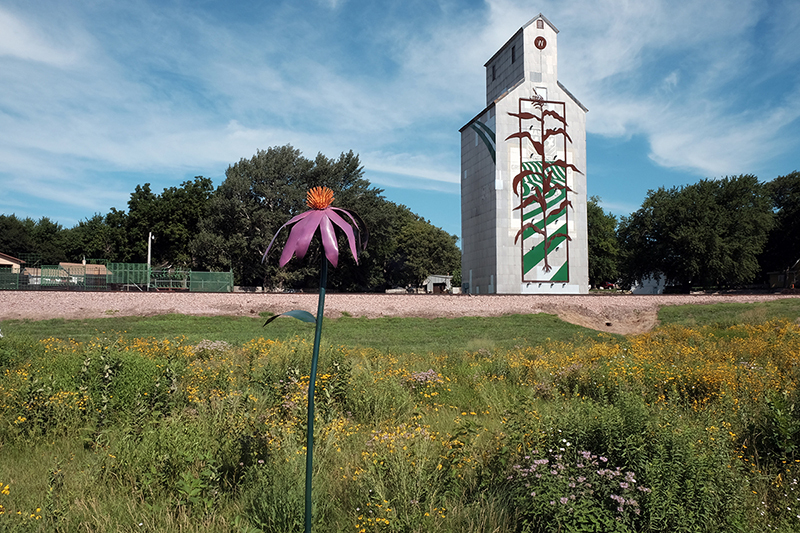
Prairie flowers bloom in front of a metal sculpture adorning a grain elevator at Woodbine's entrance. Photo by Sandra Oberbroeckling, Iowa State University.
Just beyond the grain elevator, brick roads lead to Woodbine's downtown, a National Historic District site. Sprecker points out a building constructed in 1876, the same year as the Battle of Little Bighorn, and said two of the former occupants were the founders of Hy-Vee. A century of micro-tremors from adjacent rail traffic has weakened the mortar in one of the walls, threatening its structural integrity. Current owner Dollie Bothwell, a local florist who serves three counties, is working to renovate the building and save what she calls a "slice of history."
Talking to other business owners and looking at dozens of spruced-up facades, sidewalk sculptures and planters, the story of preservation and economic development repeats itself.
"In rural Iowa communities, the school is the heart of the community, but the downtown is the nerve center," Sprecker said. "In 2008, a lot of our historical buildings were in disrepair. We had 10 vacancies and no restaurants open year-round. Today, we have on average one or two vacancies, a good balance of service and retail and close to 40 upper-story apartments."
Turning the grain elevator into public art and revitalizing the downtown created momentum to tackle other priorities, Sprecker said. A community apple orchard with 500 trees and 40 varieties is a nod to the region's agrarian past and provides free, fresh produce. Across the street, a new wellness center houses an indoor pool, walking track, gym, conference room and child care center for Harrison County residents. And in August, IGNITE Pathways opened its doors to prepare high school students for high-demand jobs and fill a gap in southwest Iowa for continuing technical education for adults.
"Many of these projects stem from Community Visioning during the 2007-08 program year," Sprecker said. "We asked ourselves, what does our community need right now, and what do we want our community to look like in 20 years?"
This past November, the Community Visioning Program hosted its annual celebration. Participants who just wrapped up the year-long process showcased their design concepts, attended grant-writing workshops and met with vendors. For the new cohort, it was an opportunity to see what’s possible and ask questions. In the fall, they'll return to share what they've learned and their plans for the future. It's all part of a growing "web of service" to support vibrant small towns across the state.
